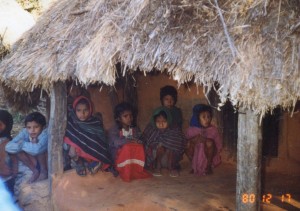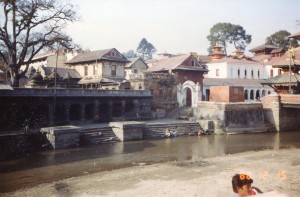Everyone was in a fix. The ocean had been swallowed up and people had no other source of water (you can read about why this happened in Indian Art’s Love of Abundance).
The Holy Ganges River flowed across the sky, like the Milky Way. But how could it be brought down to earth?
The same way that it was swallowed up to begin with. The superhuman powers that another saint accumulated with years of austerities saved the earth. He was a king named Bhagiratha, and he practiced the horrible pancatapas for 1,000 years (he sat under the merciless sun with four fires around him). It’s as hard as buying tickets in Indian railroad stations was in the 1990’s.
Even Brahma was impressed, and he granted him a wish. But they still needed Shiva’s help to bring the holy river down because its powerful torrent could cleave the earth and shatter it.
So Shiva let the river flow through his hair. His matted locks broke the current’s force, and the waters cascaded to the Himalayas, and flowed down to the Indian plains.
We can see some uniquely Indian ideas in this story, which are different from the ideas behind Greek temples and Romanesque cathedrals.
1. The river unifies the cosmos. It flows from the sky, through a god’s hair, and through all life forms’ land. All beings are thus united in a sacred river of life.
2. In the Judeo-Christian tradition, all super-human powers come from one god. But Indian mythology allows room for, not only lots of gods, but many people with super-human powers. That woman in Oxford’s Ashmolean museum really would have freaked if she had known this.
3. This multiplication of sources of incredible happenings multiplies the incredible happenings. The swallowing of the ocean by a saint with incredible powers was followed by another saint’s bringing a celestial river to earth. No wonder why 1960’s flower children were attracted to India.
4. But in India, these stories reinforced assumptions that nature is a vast field full of life force that a saintly person can tap into. The universe isn’t grounded in ancient Greek ideas of ratio, or Christian ideas of the Trinity, or of the two Biblical testaments. These ideas made the simple proportioned forms in Romanesque cathedrals meaningful. But Indians saw a vaster universe, in which great powers were less hemmed in.
This Indian vision initially converged from indigenous societys’ responses to the environment (The Origins of Indian Thought), and migrating people who brought the Vedic tradition.
Both converged when both people met around 1500 to 1000 BCE. Ganges myths were spreading from 1 to 500CE, and they helped unify India with ideas of a sacred geography. But these ideas already had very deep roots with many dimensions (the two links above will give you a good introduction to them). Ganges myths reinforced them.
And these ideas were further reinforced in visual arts. So we’ll return to the carvings at Mahabalipuram in the next post, and see a very different way of expressing reality than Greek temples and Romanesque cathedrals.



Comments on this entry are closed.